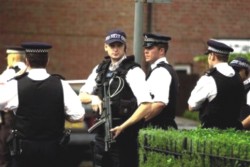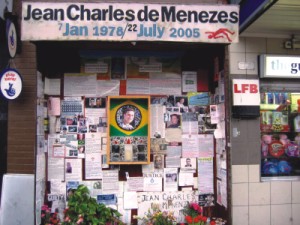|
Food for Thought
A Case of Mistaken Identity,
or Mistakes Every Step of the Way?
(Part I)
Farah Ghuznavi
 |
Members of the British Metropolitan Police have been was found guilty of making 19 catastrophic errors that led to Meneze's death. |
The growing American preoccupation with the so-called “war on terror” has (directly or indirectly) led to any number of deaths in last few years, not least because of the total disregard in some quarters for key principles of human rights and international law. While few would argue that the death of 3,000 people in the World Trade Center attacks was anything other than tragic, the fact remains that many of the actions that have been taken in the follow-up to that event have had disastrous consequences for individuals and communities; indeed, entire nations. And because of the “you are either with us or against us” approach of the Bush administration, many of America's allies have also been drawn into the distinctly dubious means sometimes employed in the name of counter-terrorism.
From the invasion and occupation of Iraq, to the shadowy policy of “extraordinary rendition” (whereby citizens of almost any nation can be effectively kidnapped from any location and taken to secret facilities for interrogation purposes), to the illegal detentions of the guilty and innocent alike in Guantanamo Bay, the lives of thousands of civilians have been destroyed as surely as those of the real terrorists who are supposedly being targeted by such measures.
There is a natural tendency to think that these activities are taking place in some dark corner of the world, or in the dark spaces inhabited by the various intelligence agencies tasked with tracking down terrorists. But the horrific situation that can be created when the clandestine activities of undercover agents collide with the mundane realities of an ordinary person's life was illustrated by the recent death of a 27-year-old Brazilian electrician in the city of London.
 |
A memorial for Menezes, a victim of the police's fatal mistake. |
The case of Jean Charles de Menezes has brought home certain frightening realisations about the lack of clarity with which some anti-terrorist activities are being undertaken. There is no question that we live in dangerous times, and sometimes only the swiftest of decisions can avert disaster, but that is all the more reason why a high degree of vigilance is required to make sure that some basic standards of efficiency and respect for human rights are maintained by those responsible for public security. Jean Charles de Menezes was killed by armed officers on 22nd July 2005 in a tragic case of mistaken identity. The police had been waiting outside his home in south London, at an address that had allegedly been connected to one of the attempted bombers involved in the abortive 21st July attacks in London. After a series of errors, which resulted in the Brazilian being allowed to board two buses and a Tube train despite officers fearing that he might be the bomber, Hussain Osman the operation ended in disaster when de Menezes was shot dead on the underground train, while members of the public scattered screaming, in every direction.
At the hearing of the case that was subsequently brought against the Metropolitan Police for allegedly failing in its duty to protect the public, a plainclothes police officer present at the shooting described the “shocking” moments during which the innocent Brazilian man was pinned down and then shot seven times in the head. The police officer had already pinned the suspect into his seat, before a member of the Scotland Yard CO19 firearms squad on his left discharged a gunshot at close range that sent shockwaves through the policeman's ear even as Mr. de Menezes was fatally hit.
The scene was completely chaotic, and the police officer heard several gunshots, though he could not be sure where they came from, accompanied by shouting and screaming as members of the public emptied out of the carriage, desperate to get away. He described the scene as “extremely violent, extremely noisy and obviously distressing… a shocking incident” (UK Independent).
Because the police officer himself was dressed “virtually identically” to de Menezes in jeans, a denim jacket and trainers, at one point he was apparently mistaken for a suspect himself, and found gun-barrels being levelled at his chest and head. “Given this, I held out my hands and shouted 'police'.” He was then dragged away from the scene before putting his black police cap on.
As the police officer made it clear, the police had been uncertain as to the identity of de Menezes. “I requested via my radio whether or not Menezes should be detained. I received the reply that I should wait… I was certainly in a position to effect some sort of detention”, he said, making it clear that the tragedy could have been averted, or at least made less traumatic for all concerned, by detaining the Brazilian before he entered the underground station.
As a result of the incident, Scotland Yard faced a prosecution under health and safety legislation for the alleged “fundamental” failures that led to the de Menezes shooting, but the force denied the charge that it had put the public at “undue risk of danger” during the surveillance operation when the Brazilian electrician had apparently been mistaken for Hussain Osman, a would-be bomber.
At the trial, the court heard that during a six-hour period on July 22nd, a number of failures took place in the security operation that included a four-hour delay in sending a team from the firearms unit to support the surveillance team, as well as a critical communications breakdown in the “noisy and chaotic” control room which led senior officers to wrongly believe that the de Menezes had been identified five times as Hussain Osman (UK Independent)!
But a number of tactics adopted by the defence team in court were heavily criticised. Prosecutors told jurors at the trial that they believed an image shown in court had been altered to create a misleading similarity between de Menezes and Hussain Osman. The photograph consisted of half the face of each man, and by placing the two pictures side by side, lawyers for Scotland Yard had sought to indicate that it was difficult for officers tracking de Menezes to differentiate between the two men.
However, a forensic expert told the court the picture of the Brazilian in the police photograph appeared to have been brightened and the definition of some of his facial characteristics had been reduced. The court was then shown an alternative composite in which the two men's faces had distinctly different skin tones and their mouths and noses were not aligned (unlike the police photograph). When the trial judge questioned a police witness about whether there had been manipulation of the “primary features” of de Menezes' face, he responded, “I don't believe there has been any. But making the image brighter has changed the image.” Hardly a robust denial!
This was not the only tactic of the defence lawyers that was challenged by the judge. When Scotland Yard's lawyers were attempting to raise questions about the Brazilian man's immigration status, stating that de Menezes' permission to remain in the UK would have in any case run out the day after he was killed, the judge responded, “He is a member of the public who is entitled the protection of the Health and Safety at Work Act whatever his status, is he not?”
The family of the dead man expressed fury at the conduct of Scotland Yard and its lawyers during the trial, accusing the police of a “sickening” attempt to smear the Brazilian's reputation by suggesting that his behaviour and personal life could have contributed to his death. Although subsequent viewing of CCTV footage indicated otherwise, the force had alleged that the Brazilian behaved in a suspicious manner on the morning of the operation, contributing to the case of mistaken identity. The jury was also told that a post-mortem examination had shown that de Menezes had taken cocaine, although it was considered highly unlikely that the drug could have still been affecting him on the day of his death.
In the end, 831 days after Jean Charles de Menezes was shot dead by the police, the Metropolitan Police was found guilty of making a total of 19 catastrophic errors in the operation that led to his death. While the trial judge stated that no single individual could be held personally responsible for the failings that led to de Menezes' brutal death, he emphasised that Scotland Yard had fallen short to a “significant and meaningful extent” and that important aspects of its conduct remained unjustified.
The force was fined 175,000 pounds and ordered to pay legal costs of 385,000 pounds after it was found unanimously guilty of the charge of breaching section 3 (i) of the 1974 Health and Safety at Work Act, which requires all employers to do everything reasonable to protect the public from harm during their activities. The jury took less than 5 hours to reach a verdict.
(to be continued…)
Copyright (R) thedailystar.net 2008 |
